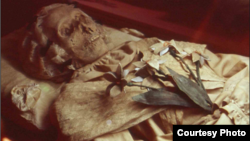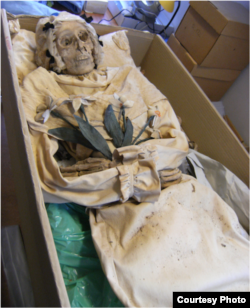Researchers have found tuberculosis bacteria in human remains uncovered in a 200-year-old Hungarian crypt. The finding reveals that TB affected many in the European upper classes in the 18th century, painting a different picture of the disease than is seen today.
Tuberculosis mostly afflicts poor people and those infected with the AIDS virus in the developing world, in general sparing the well-to-do.
But that was not the case in Europe of two and a half centuries ago when the upper classes were also stricken the fatal lung disease.
The mummified remains of eight of the 26 people found in ornate coffins in the Dominican Church in Vac (VATS), Hungary yielded 14 tuberculosis genomes. There were multiple strains of TB in five of the mummies.
Mark Pallen of the University of Warwick in Britain said the evidence shows it was common for people back then to be infected with more than one strain of TB — simultaneously.
“What we think of today ... is normally each person has got one strain and that’s our assumption, that’s our working assumption of how TB is," he said. "But what we found here was actually that wasn’t the case, and that we actually found two or three different genotypes present in individuals from these samples.”
Pallen said researchers discovered a mother and daughter who were both infected with multiple TB strains, which they may have transmitted to each other.
The DNA was easily extracted from samples of the mummies’ tissue. The Pallen team used a technique called “metagenomics” to identify TB DNA in the tissue samples directly, rather than using the more difficult task of growing bacteria in culture to analyze the genetic material.
Because multiple TB strains were found in five of the bodies, researchers speculate many people at that timne were infected with tuberculosis, which spread easily through the population.
Today, researchers say multiple infections have been discovered in South Africa, which is rife with HIV and cases of antibiotic resistance.
Being infected with more than one strain of the TB pathogen makes it difficult to treat the illness with conventional methods.
Pallen said clinicians may have to start thinking differently about TB diagnosis and treatment.
“I don’t think I can claim single-handedly to have changed the field in any way," said Pallen. "But it’s just changing the way people think, and it’s just making people think more carefully about assumptions about what we do at the moment.”
Pallen said an analysis of the mutations in TB samples, both old and new, suggests a common ancestor for the tuberculosis bacterium existed nearly 6,000 years ago, as far back as the late Roman period.
An article on analysis of the 18th century mummified bodies is published in the journal Nature Communications.










